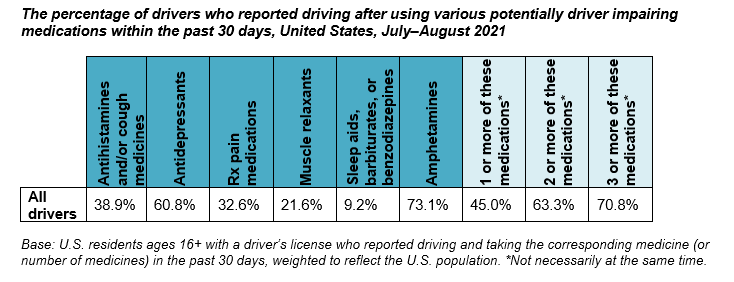PORTLAND, Ore., – A new study from the AAA Foundation for Traffic Safety finds that half of drivers surveyed say they used one or more potentially impairing medications in the past 30 days. Many who took medications to treat depression, pain, or sleep issues were not warned by their healthcare provider regarding the possible dangerous impact on driving. And many drivers don’t realize how these meds can impact their ability to drive safely.
Many potentially driver impairing (PDI) medications can have effects that can be dangerous when mixed with driving, including dizziness, sleepiness, fainting, blurred vision, slowed movement, and attention problems.
“Our research finds that many drivers are taking one or more potentially impairing medications before getting behind the wheel, and many drivers don’t realize the impact these drugs can have on their decision-making and reaction time,” says Marie Dodds, public affairs director for AAA Oregon/Idaho.
AAA recommends that the advice given by medical and pharmacy professionals about the dangers of mixing over-the-counter and prescribed medications with driving must be greatly improved and more consistently emphasized to maximize traffic safety. AAA says medical professionals need to provide clear advice to their patients of the possible risks and ensure they understand them.
Here is the research brief.
This study focused on the prevalence of recent use by drivers of commonly used prescriptions and over-the-counter medications such as:
- antihistamines and cough medicines (such as Claritin, Allegra and Benadryl),
- antidepressants (such as Prozac, Zoloft and Wellbutrin),
- prescription pain medicines (such as Tylenol with codeine, OxyContin, Percocet, and Vicodin/hydrocodone),
- muscle relaxants (such as Soma and Flexeril),
- sleep aids (such as Ambien, Lunesta, phenobarbital, Xanax, Valium and Ativan),
- amphetamines (such as Adderall, Dexedrine, and phentermine).
These are PDI medications, but not all drivers who reported taking them were impaired. As the term implies, PDI medications can potentially impair driving, but effects in individuals may vary.
Antihistamines and cough medicines—many available without a prescription—were most commonly used. However, the proportion of drivers that reported driving after use was highest for those who reported amphetamine use, such as Adderall and Dexedrine, as shown in the table below.

Research results found that up to half of drivers who were prescribed and took each type of PDI medication did not report receiving a warning from their medical provider or pharmacist regarding its possible impacts on driving. But those who did receive a warning were 18% less likely to get behind the wheel after use, highlighting the potential benefit of healthcare providers’ counseling to reduce medication-impaired driving.
“Our research shows that doctors and pharmacists can play a crucial role in educating patients so that they can use the medications they need for their health but also stay safe when driving. Unfortunately, we find that too few medical professionals provide this information or suggest ways patients can navigate this challenge,” adds Dodds.
Anyone taking PDI medications should discuss with their doctor or pharmacist ways to preserve safe driving, such as adjusting medication doses, the timing of those doses, or alternative medications to treat medical conditions without causing driver impairment.

For drivers, AAA recommends these safety tips:
- Don’t Underestimate the Risks of Driving after Using Medications—Over the past three decades, society has realized the dangers associated with drunk driving. According to the latest AAA Foundation Traffic Safety Culture Index, most drivers (94.5%) consider driving after drinking alcohol very or extremely dangerous. But only 87% feel the same about driving after using potentially impairing medications.
- Be Aware of Your Options—With advice from your doctor or pharmacist, you can successfully treat your medical condition and maintain your ability to drive safely. Options include, but aren’t limited to, timing your doses to avoid times when you need to drive, adjusting how much medication you take, or even exploring alternative medications that treat your symptoms without causing impairment.
- Advocate for Yourself—Become a better advocate for yourself during visits to the doctor, when filling a prescription at the pharmacy, or purchasing over-the-counter medications. AAA recommends that consumers be proactive by asking the doctor or pharmacist how the medications could affect driving ability and how to avoid those risks while treating their medical condition. If the medicine is available over-the-counter, read and follow the warnings, and/or consult a pharmacist for advice.

About AAA Foundation for Traffic Safety
Now celebrating its 75th anniversary, the Foundation for Traffic Safety was established in 1947 by AAA. The Foundation is a nonprofit, publicly funded, 501(c)(3) charitable research and educational organization. The AAA Foundation’s mission is to prevent traffic deaths and injuries by researching their causes and by educating the public about strategies to prevent crashes and reduce injuries when they do occur. This research develops educational materials for drivers, pedestrians, bicyclists and other road users.
About AAA
Started in 1902 by automotive enthusiasts who wanted to chart a path for better roads in America and advocate for safe mobility, AAA has transformed into one of North America’s largest membership organizations. Today, AAA provides roadside assistance, travel, discounts, financial and insurance services to enhance the life journey of 62 million members across North America, including 56 million in the United States. To learn more about all AAA offers or become a member, visit AAA.com.
AAA news releases, high resolution images, broadcast-quality video, fact sheets and podcasts are available on the AAA NewsRoom at NewsRoom.AAA.com.
Find local news releases at https://oregon.aaa.com/community/media/media-contacts.html

